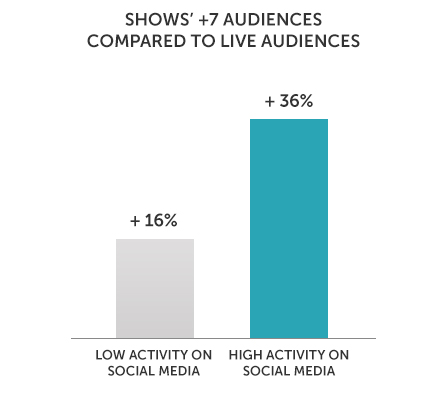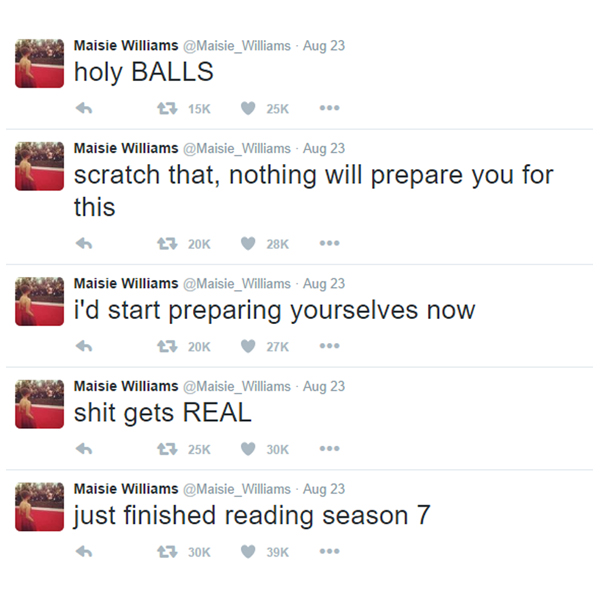We’re all familiar with the phenomenon of the ‘second screen’. That people browse their Twitter and Facebook accounts while watching TV. It’s never been easier to comment on what we see on TV and share it with the rest of the world. There’s even a chance our tweet will get into one of the “Twitter reacts to ….” articles. Or the Mean Tweets segment on Jimmy Kimmel Live. But can activity on social media make people tune in to TV shows?
Some background stats & facts
There is a good chance of boosting TV viewership with social media activity, according to recent studies. One of these found that those who click on shared content about a particular TV series are nearly 2.5 times more likely to become viewers.
Check out our other stories:
- Improve your social broadcasts with different content types
- 8 common live streaming mistakes
- What indicates success? The social video KPIs that count
A study by Nielsen also found that a 10% increase in impressions on Twitter (measured with using Nielsen’s Twitter TV Ratings) corresponds to a 1.8% increase in viewership within 7 days of broadcast. Additionally, programmes highly active on social media have +7 audiences 36% larger than live audiences. For those with low social media activity the increase is 20% lower.

How we watch TV is changing
Deloitte found that as many as 90% of Americans tend to multi-task. Only one-fourth of their activities is related to the watched programme.
TV is also losing out to digital streaming. NBC TV Ratings for the 2016 Rio Olympics were 15% lower than for the London Olympics in 2012. However, NBC also had about 100 million unique users on desktops and smartphones who streamed a total of 3.3 billion minutes of the games!
More proof?
According to Defy’s fourth annual Acumen Report, only 36% of the Gen Z and millennial consumers said they can’t live without traditional TV, compared to 67% without YouTube.
With younger generations only likely to have greater influence in the future, the impact of social media on TV ratings is probably still not at its peak.
If you want your TV program to succeed you need to be active on social media, especially Twitter. But it needs to be done well to be effective. So here’s a handy guide about what to post, when and how.

What to post:
The short answer: videos. They perform the best and will have the highest organic reach rates on Facebook (when compared to other digital formats). Twitter claims that 82% of users watch video on its platform.
As a broadcaster you probably have access to quite a few videos, which will be a source of ever-green content for you to choose from. You might delve into your archive for older videos, or utilise previews of future shows.
Where possible you should try and share what’s happened in real-time, such as news clips. This will help you to create a buzz on social media. Or provide you with an opportunity to add something new to trending topics.
[bctt tweet=”Where possible you should try and share what’s happened in real-time. ” username=”TellyoTV”]Remember to include a link with anything you post too. Particularly if what you’re trying to promote is also available as an online stream. A link will drive people to the online stream where they can view more.
When to post:
The content you post will obviously differ depending of the type of programme. But the timing of your posts can be generalised into three groups:
- Before the show
Remind people that your programme is starting within the next ‘x’ minutes. Post best moments from the previous game/episodes. You might also post trailers of ones that are about to start etc. - During the show
Especially relevant for sports, as the activity of Twitter users is known to peak during a match, particularly at moments of action. So share those moments as quickly as possible. Show those who do not watch what they’re missing, as soon as it happens! - After the show
Time-shifted viewing has become more and more important. Some networks are seeing over 50% of their 18-34 aged viewership coming in the seven-day window after the live airing. This probably applies to you, too. Remind people that they can catch up with the latest episode of your show online.
How to post:
Your viewers will prefer human-to-human communication rather than a business-to-human one. Actors and talent are the most-preferred sources of tweets – with about 40% of respondents saying they prefer actor/talent tweets, while just 18% said they prefer official Twitter handles of TV shows. For example, Mark Ruffalo and Chris Hemsworth have much more engaging tweets than the Thor and Hulk official movie account. Maisie Williams’ tweets (the actress playing Arya Stark in Game of Thrones), got thousands of engagements when she posted about the upcoming season of the show.

Maisie Williams tweets about the next season of Game of Thrones
got thousands of engagements
You might ask: Was it a part of the Game of Thrones’ marketing strategy? We will never know for sure, but it certainly seemed very well planned and executed. What Maisie Williams’ tweets demonstrate though is that simple, natural tweets reminding everyone and creating a buzz (about a show that won’t continue until mid-2017) are the way to go.
So, can you influence the members of your TV show– whether it’s a series, contest or sports match – to share things on their official social media channels? If ‘yes’ or ‘I can try’, then do it. Start creating a buzz now in order to drive more interest and engagement.
If you follow the above tips you should start to get results. If you need a tool for real-time editing and sharing during your shows, try Tellyo. It lets you share your video clips in less than 1 minute, enabling you to publish them across your social media channels simultaneously.



